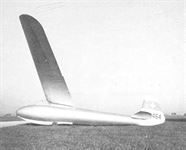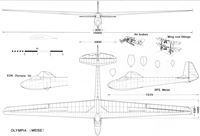Варианты
- DFS - Meise - 1938 - Германия
- Elliotts of Newbury - Olympia / Type 10 EoN - 1947 - Великобритания
M.Simons The World's Vintage Sailplanes 1908-45
THE MEISE/OLYMPIA
In the mid 'thirties, a strong move was made to introduce gliding into the Olympic Games. The Olympic Committee became convinced that the sport should be included. The next Olympics were to be in Japan but this was changed to Finland as a consequence of Japanese involvement in war with China. It was decided that, in keeping with the spirit of the Olympics as tests of men rather than of machines, all the competing pilots should fly identical sailplanes. A design competition was devised to select the standard Olympic type. The materials to be used were to be readily available everywhere. Both Japan and Finland had very restricted areas for landing sailplanes after crosscountry flights, so it was insisted that no wheel should be fitted, to shorten the landing run. The wingspan was limited to fifteen metres, the empty weight was not to exceed 160 kg and the all-up weight in flight had to be below 262 kg. These figures were based on accepted successful design practices and were quite attainable without any new or difficult techniques in design or construction. The cockpit was to be large enough to accept a range of different pilots and the design maximum speed was 200 km/h. Since it was thought that there might be some aerobatics in the contest, the load factor used was to be 10 instead of the usual 8.
The design contest was held at Sezze in Italy near Rome, in February 1939. Not all the promised entries turned up for test flying, but six did so, the Olympic Orlik from Poland, the AL 3 and the Pelicano from Italy, the Swiss Spalinger 18 and the Mu 17 and Meise from Germany. The Meise was designed by Hans Jacobs of the DFS. All the entries were flown and examined by a team of engineers and pilots including representatives from Hungary, Switzerland, France, Italy, Poland and Germany. Only two of the aircraft were judged to have met the specification fully, the Orlik and the Meise. In the end, the Meise was selected although subsequently the Poles complained that the Germans had exerted unfair influence on the Italian judges and so swung the vote their own way.
Plans of the Meise/Olympia were duplicated and distributed all over the world for each competing nation to build its own sailplanes. The 1940 Olympics never took place for by that time Finland was at war with the USSR, and Germany with Britain and France. Poland was under occupation. The Meise, however, was selected by the NSFK for mass production as a sailplane of medium performance and it was to become one of the most popular and influential sailplane designs ever to appear. (The name, Meise, is pronounced approximately ‘miser’, and is the German word for titmouse.)
Jacobs intended little more than to produce a 15 metre version of his already successful Weihe. The span was reduced and the straight-tapered planform was retained. The root aerofoil was Goettingen 549 thickened to give a greater depth of mainspar. With ample aileron area, the Meise had a better rate of roll than the larger aircraft. Airbrakes of the superior ‘parallel action’ type were used instead of the relatively ineffective variety on the Weihe. The unusual rigging system of the wing used on the Weihe, was abandoned for the more orthodox diagonal spar and rear drag attachment fitting, with a light auxiliary spar to stiffen the wing ribs and carry the aileron hinges. The mainspar was of simpler 'I' section instead of the somewhat more difficult to build box form.
The fuselage was similar in general outline to the Weihe, with the same high-mounted wing position, but the rear portion, from wing root to tail, had an almond or lens-shaped cross-section which was easier to build than the more common round-backed shape. A fairly stout keel and a dorsal longeron of similar size gave good glueing area for the plywood skin, which could be applied in separate pieces on each side, without having to bend the sheets round the curved back of the fuselage. This resulted in a rather untidy wing/fuselage junction, there being an awkward angle near the trailing edge on the underside. Jacobs did not design any elaborate wing root fairings to improve this, as he considered the cost was not justified in terms of performance.
The cockpit was roomy with space for a ‘back type’ parachute. The canopy was a light steel framework with panels of transparent plastic riveted on, the rivet heads being covered by a light aluminium strip. The landing gear was the usual rubber-sprung skid. The tailplane and rudder were almost identical to the Weihe, but were smaller, and the tailplane was attached by means of only one bolt.
The Meise was universally agreed to be both safe and responsive. Philip Wills, on first flying one, described it as a piece of aerodynamic poetry. Mass-produced in Germany until the closing stages of the war, the Meise was turned out in greater numbers than any other single-seat sailplane up to that time, except for the Grunau Baby. Some of these German sailplanes remained to be flown by the occupation forces when the war ended, though many others were destroyed. Probably more than 1,000 were built at various factories in Germany and elsewhere in occupied Europe. Some were also built under licence in Sweden.
In 1945, Olympia plans were readily available, the type now well-proven, so it was a natural choice for production outside Germany. In France it was re-christened the Nord 2000 and 100 were built. In Britain, the Chilton Aircraft Company began to offer the Olympia for post-war production as early as 1944, and received a number of orders.
Although designed for easy construction, the British felt that the Olympia was unnecessarily complex. Various simplifying changes were made, bolts and rivets being converted to British sizes and the aircraft was re-stressed to the current British requirements. The most noticeable external alteration was the replacement of the framed canopy by a blown Perspex bubble.
Even before the first Olympia was completed, the Chilton Company sold the rights to the firm, Elliotts of Newbury, who built 100 Olympias. There was some further re-design at this stage and the Olympia was again re-stressed, for airworthiness requirements had now been laid down by the Air Ministry rather than the British Gliding Association. The result was a somewhat heavier Olympia with an empty weight about 30 kg more than the Meise. The first few Elliot Olympias were delivered to clubs and private owners during March and April, 1947. Before long Elliotts brought out the Olympia 2b, which had a wheel instead of a skid. Many of the earlier Mark 1 Olympias were modified retrospectively to the Mark 2 standard. A third version was advertised with a drop-off dolly, but very few were sold in this form. Later another 50 Olympias were built.
The mass production of Olympias changed British gliding almost overnight and in Europe it became the normal sailplane for performance flying. Except for a few surviving Weihes, competitions for a time became virtually ‘one design’ contests where most pilots flew identical aircraft. Soon the idea was revived of a ‘standard’ sailplane: thus the present Standard Class concept can be seen to have begun with the Olympic Games proposal of 1936.
Production of Meises continued in Holland and Switzerland and, after 1951, in Germany again. Elsewhere a few were built by amateurs. Of these, the most famous is probably the Yellow Witch built in Australia by Ken Davies and Arthur Hardinge during 1947-48. The plans came from the Chilton Aircraft Company and so were closer to the Meise than to the Elliott Olympia. Hardinge flew the Yellow Witch at Christmas 1948, and a few weeks later shipped it to New Zealand for a barnstorming tour to stimulate soaring in that country. The interest aroused was very great and marked the revival of the New Zealand gliding movement. The Yellow Witch returned to Australia, was sold by Hardinge and remains still airworthy at the time of writing.
A good many other Olympias and Meises are still in service although now are considered too slow for advanced competition racing. They still delight pilots with their well balanced controls and docile handling.
Technical data:
Meise: Span, 15.00 m. Wing area, 15 sq m. Aspect ratio. 15. Empty weight, 160 kg. Flying weight.-255_kg. Wing loading. 17 kg, sq m. Aerofoils, Goettingen 549 at root, Thickened to 16% and tapering to Goettingen 676 at the tip, with washout of 5 degrees. Best glide ratio. 1 : 24.5 at 64 km/h. Minimum sinking speed, 0.67 m sec at 56 km/h. Maximum permitted speed, 220 km/h.
Nord 2000: As for Meise but empty weight, 176 kg. Flying weight 271kg. Wing loading, 18.00 kg/sqm. Maximum permitted speed, 170 km/h.
Olympia 2: As for Meise but empty weight, 195 kg. Flying weight, 304 kg. Wing loading, 20 kg/sq m. Maximum permitted speed. 208 km/h.
Описание:
- M.Simons The World's Vintage Sailplanes 1908-45
- M.Hardy. Gliders & Sailplanes of the world
- Flight, June 1939
STANDARD SAILPLANE for OLYMPIC GAMES
Фотографии
-
GL / M.Simons - The World's Vintage Sailplanes 1908-45 /Kookaburra/
Регистрационный номер: HB-384 Small brother to the Weihe, the Meise or Olympia was in many respects a 15-metre version of the earlier, 18-metre design. The Swiss example shown differs hardly at all from the German type.
-
GL / M.Simons - The World's Vintage Sailplanes 1908-45 /Kookaburra/
Регистрационный номер: D-11-240 The Meise prototype D-11-240 at Sezze in 1939, ready for judging in the Olympic sailplane design contest, which it won. The cockpit canopy was a simple steel tube framed structure covered with curved pieces of plastic. The machine's handling characteristics were outstandingly good.
-
GL / M.Simons - The World's Vintage Sailplanes 1908-45 /Kookaburra/
A Meise on winch launch in Switzerland.
-
GL / M.Simons - The World's Vintage Sailplanes 1908-45 /Kookaburra/
A Meise in silver dope with Swiss markings.
-
GL / M.Simons - The World's Vintage Sailplanes 1908-45 /Kookaburra/
Регистрационный номер: HB-381 A restored Swiss Meise which flew in the vintage rally at Brienne-le-Chateau in 1978. The fuselage was vivid red, the wings and tailplane being silver-blue with yellow bands across the wings.
-
Flight 1939-06 / Flight
Details of the neat system of spoiler operation.
- Фотографии









